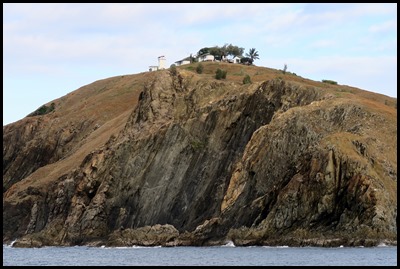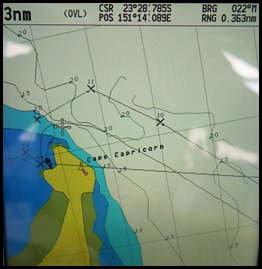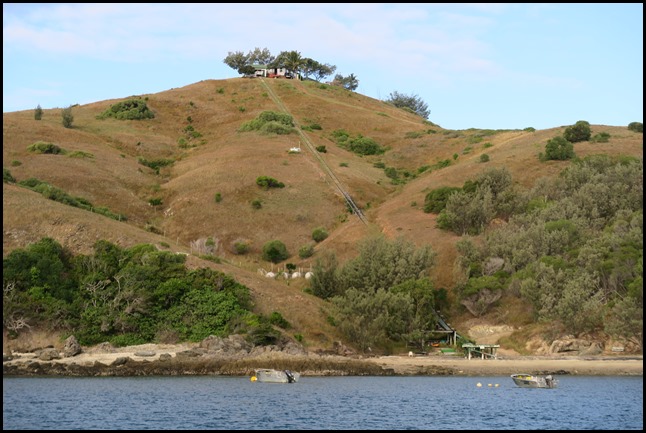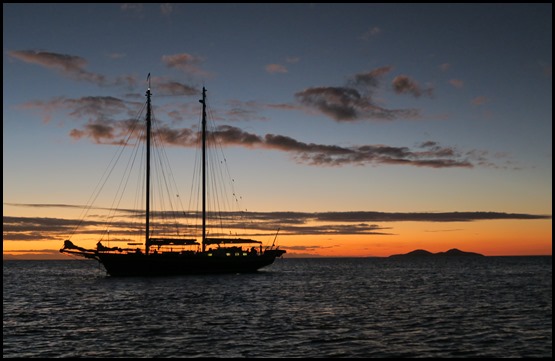To Cape Capricorn

|
To Cape Capricorn
 A wave to the
posse and off we went at seven o’clock. Just like yesterday, Bear said
those joyous words, you’ve got much more water below you
than when I came in. Yeeha, colour me happy.
 I passed the green marker with nary a
drop in depth, then over the bar with 2.8 below, moments later out into 6 metres
and a hail to the skipper that he “could proceed with the main” in my bestest
first mate voice.
 At half past nine I thought I could
see a new-to-us-but-very-familiar-shape parked behind
a chum.
 Oh yes,
then she popped up on the AIS.
 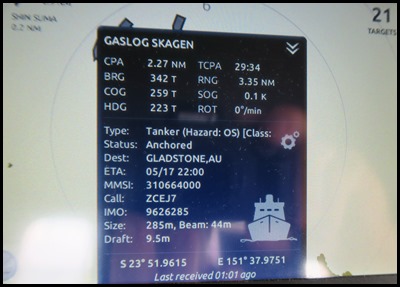 Well, colour me happy for the second
time today. We were about to go through a car park of
chums, not done since Panama and the first lady to take a closer look at
was Gaslog Skagen, a sister ship to our brand new chum from yesterday,
Gaslog Greece. Oh, I had to go straight on to their website for a good
look – amazing to have internet as we’re pootling along. Bear wanted to know
about how they loaded LNG, well I took great delight in looking it up and
reading it out to him. There is much to do, heating, cooling, changing gases,
burning off the bad bits, in fact, quite a technical performance.
 Next up was Albany Sound from Hong Kong. We waited until we passed
her to get the yacht in the picture to show how huge these girls really
are.
 Then came Yue
Dian 83, just arrived from Bontang in Indonesia.
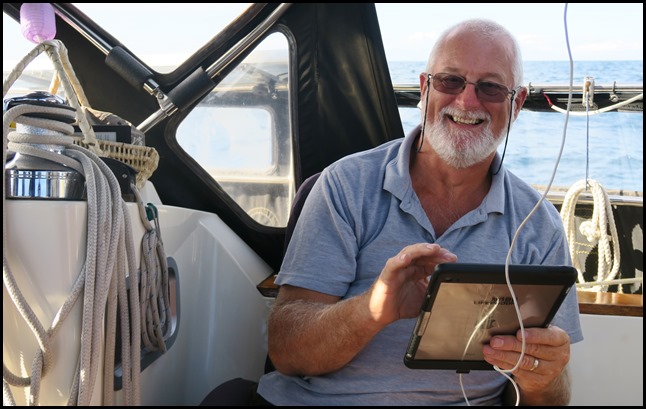 Bear
happily looking the ladies up. Yue Dian 83’s details are as dictated to me by
my beautiful secretary..... IMO: 9553775,
MMSI: 477962600,
Type: Bulk Carrier,
Gross Tonnage: 47984,
Summer DWT: 87329,
Build: 2010,Flag: Hong
Kong.
 The daunting view you never
want out at sea, but here, awesome.
 Just her left anchor down we
could just make out a brown booby sitting on each point of her right
anchor.
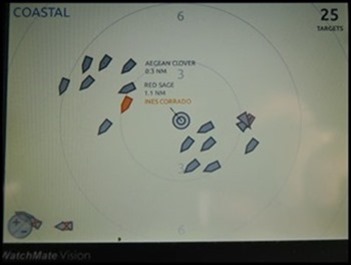  Another look at the AIS
screen, well what do you know, Aegean
Clover from Panama.
 Sad to leave the ladies
behind, but onwards and upwards, great fun while it
lasted.
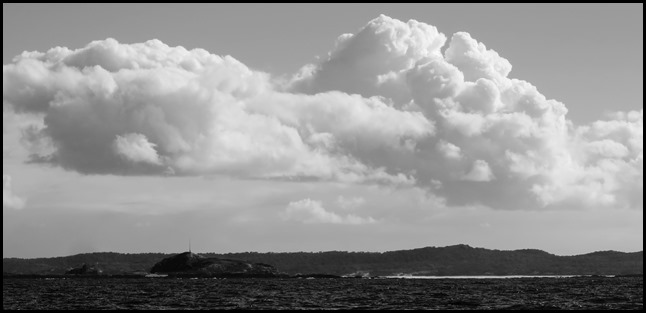 A look to our left at some
lumpy bits.
 The scenery in the
distance.
 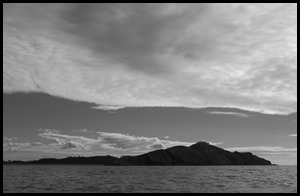 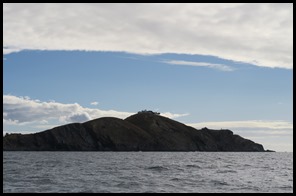 Messin’ with clouds as Cape
Capricorn comes into view.
 Away to our right Hummocky
Island, further right – Ship Rock.
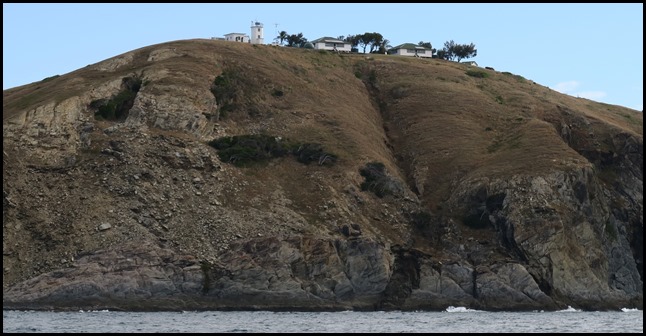 Passing the somewhat ‘stumpy’ Cape
Capricorn Lighthouse and cottages.
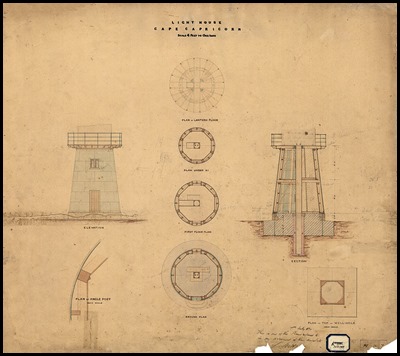  The first lighthouse plan,
1874 and the second plan
1937.
Cape Capricorn Lighthouse may not have the same tragic history as the Pancake Creek Lighthouse but it has it’s own unique story, Wiki says: First lighthouse: The colony of Queensland was formed with the signing of Letters Patent by Queen Victoria in 1859. The need for pilot assistance accessing the mouth of Fitzroy River and the Port of Rockhampton necessitates the construction of a pilot station on Curtis Island. The first permanent station was established on Cape Capricorn as early as 1861. Though it was moved to Grassy Hill three years later, the need for a lighthouse at Cape Capricorn remained a priority. Plans for a lighthouse and cottages were prepared in early 1874 by the office of F. D. G. Stanley, Queensland Colonial Architect, with an estimated cost of £1460 for the lighthouse and cottages. The lighthouse, a typical Queensland timber framed and iron clad structure, was to be prefabricated and built in Brisbane. However, the only response to the first tender was an overpriced offer of £2850. The second tender was more successful, the winning offer being by James Midson for £1046/10/-. The construction was completed sometime in October 1874, and an additional contract was granted to Midson for the erection of the structures on the site for the sum of £753. Quite remarkably, a last minute change in the order of the lantern from England meant that no lamp room was ordered. An urgent request for an additional £180 was made by Stanley for construction of a lamp room from timber framing with iron plating, instead of the planned cast iron one. The lighthouse was operational around late July 1875. The original light source was an oil wick burner. An 1895 survey also reports two additional auxiliary lights on Cape Capricorn, to the north and southeast of the main lighthouse. Supplying the station was done from Rockhampton, and was quite a difficult task. Supplies were brought to the base of the hill by steamboat and then manually winched up over 91 metres (299 ft) on a tramway. An assessment made by Commander Brewis in 1912 recommended increasing the power of the light, adjusting the eastern auxiliary light, renovating the dwellings, repairing the tramway and supplying steam winches. However, this recommendation was to be followed very slowly and partially. However, in July 1915 the lighthouse was transferred to the control of the federal government, and it took eight more years until in 1923 the light source was finally replaced with a 55 millimetres (2.2 in) incandescent vapourised kerosene mantle. In January 1936 plans were prepared for electrification of the light. However, it is not clear if this change was made, as in the same year it was decided to replace the tower.
Second lighthouse: In 1936 the Commonwealth government decided to replace the tower with a new concrete block lighthouse, and plans were prepared in September 1937. The new tower was a 6-metre-high (20 ft) square structure, with an adjoined power house. The tower was topped by a cantilevered circular balcony and a small circular lantern. At the same time the residences and service buildings were also replaced with timber framed asbestos clad structures. The new lighthouse was made operative with electric power in 1938. However, from undetermined reasons this lighthouse was to be short-lived, surviving only 26 years more to be replaced by a new structure in 1964. Third lighthouse: Plans for a new powerhouse and lighthouse were made in January 1962 and July 1963 respectively. By 1964 construction was complete and the new light was operational. It was the first of a group of seven concrete towers erected between 1964 and 1979, followed by New Caloundra Light, Point Danger Light, New Burnett Heads Light, Fitzroy Island Light, Point Cartwright Light and Archer Point Light. In 1968 the light source was converted to 240V AC operation. Since its construction and until 1978, Cape Capricorn lightstation served as the base radio station for a network of lighthouses in the area including North Reef Light, Lady Elliot Island Light, Pine Islet Light and Dent Island Light. On 18 December 1978 this role was transferred to Bustard Head Light. On 8 December 1983, the House Standing Committee on Expenditure tabled its report on the inquiry into lightstations entitled "Lighthouses: Do we keep the keepers?". The report recommended the demanning of 24 lightstation, including Cape Capricorn. In 1988 the station was finally converted to solar power (and presumably demanned). The lantern has been removed, and a self-contained beacon was installed. Ownership of the station was transferred to the Great Barrier Reef Marine Park Authority in 1991, back to the Australian Maritime Safety Authority in 1995 and then to the Queensland Government in July 1997, which employs a caretaker at one of the residences. The rest are privately leased.
Time to pass the amazing rock formations of Cape Capricorn and sneak round Clews Point to anchor.
We were the first yacht in, safely tucked in the shelter – what a view of the old tramway up to the lighthouse and cottages, later there would be a gang of four of us including a big lady. In the calm sea and gentle breeze all was comfy. I lost again at backgammon but snuck a win at the last minute in Mexican train dominoes. There were a couple of times when our pieces fell over in a little roll – it would be awful to anchor here in big seas and winds. We enjoyed the sunset and the final picture is ‘big lady’.
ALL IN ALL A CHUMS
DELIGHT
GREAT TO SEE SO MANY
CHUMS |

